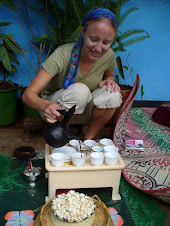Today marked the Ethiopian celebration of Timket (Epiphany). The festivities began over at KB's house with her landlord's family moving all their furniture out of the house and into the renters' quarters they will occupy during KB's stay. Generously, though, they left behind the neon-lit Orthodox Jesus icon clock hanging on the living room wall, not wishing to deprive us of the friendly face we have come to know and love as Disco Jesus. From his lofty seat in the living room heavens, he watched over the frenzied exodus of chairs, tables, and footstools, shining forth his blessings in the form of green, blue, and purple rays of light that swirled and danced behind him.
The dust had barely settled, and KB had barely been afforded the time to grasp the sudden and unannounced departure of the furniture that had once graced her house, when we were summoned again to action. Drumbeats, shouting, and singing announced the arrival of the Timiket procession. We hurriedly donned our traditional Ethiopian finest and scurried up the hill to join it. The streets were flooded with people clad in the traditional flowing white of Ethiopian religious celebration. Another less traditional clothing trend evident within the crowd was that of blue jeans, American pop culture t-shirts, and knock-off European football jerseys, popular among the teenage crowd on this major Orthodox holiday. A stream of iridescent parasols in every color of the rainbow glinted in the
At the top of the hill, we were swept through the gates of the church, tall arches painted boldly in patriotic red, yellow, and green. We joined the crowd in circling the round church building three times, singing and clapping all the more loudly now for having reached our destination. Church elders in assorted white headdresses led the singing from the circular veranda of the church. Old women trilled their cries of triumphant celebration, while boys beat large skin-covered drums and blew zealously on metal horns. Once our three requisite revolutions had been completed, the crowd spontaneously formed into circles for dancing. Tsintayo spotted some of her friends and dragged me by the hand through the crowd to their circle (mercifully shaded from the intense Ethiopian sun by a small stand of trees). We clapped and laughed together as people from the crowd took turns dancing in the idle, some voluntarily, some forced by the collective will of the mob. There was a brief, enthusiastic campaign to pull the farenji into the middle, but, freely admitting my inferiority to their incredible skill, I adamantly preferred to watch. The dancers moved in impossible gyrations of their upper bodies within the ring of onlookers, and Tsintayo and I amused ourselves in the safety of the perimeter with comical attempts of the same.
Heading back down the hill again toward home, we were still laughing and shaking our shoulders to the drumbeats we had left behind us. When we reached the house and parted ways, we expressed the hope of celebrating together in the same way, with the same joy, at the same time next year.

No comments:
Post a Comment